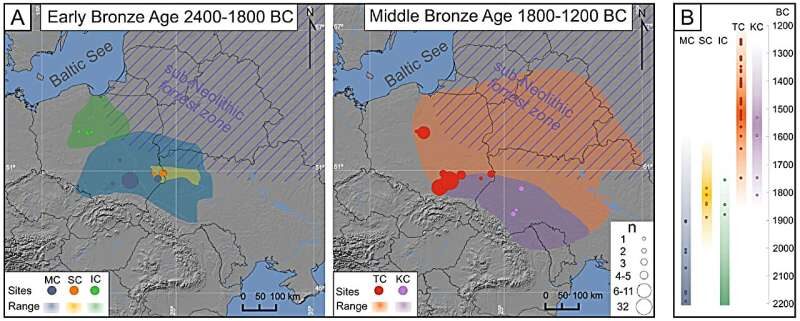Bob Yirka
Phys.orgWed, 02 Aug 2023 15:04 UTC

© Nature Communications (2023). DOI: 10.1038/s41467-023-40072-9The geographical and temporal context and genetic affinities of the analyzed Bronze Age individuals. A) Maps showing the locations of samples published in this study and the geographical range of their associated cultural entities; the size of the marker corresponds to the number of samples from each site. The map was created using QGIS 2.12.2 and basemap from NOAA National Geophysical Data Center. 2009: ETOPO1 1 Arc-Minute Global Relief Model. NOAA National Centers for Environmental Information. Accessed 2013. B) The age of the newly generated genomes (calculated as an average of 2σ BCE dates) corresponding to the temporal range of the archaeological cultures they are associated with.
A team of researchers with a wide variety of backgrounds from institutions in Poland, Sweden, the U.K., Czech Republic and Ukraine has learned more about the demographic history of people living in East-Central Europe during the Bronze Age by studying the genes of people living during that time. For their paper published in the journal Nature Communications, the group conducted genetic analyses of temporal bones and/or tooth remains of 91 people.
As the research team notes, most
demographic research focused on early Europe has been quite generalized, spanning from the postglacial spread of
hunter-gatherers to the growth of migration by farmers. In this effort, they sought to better understand such demographic events in better detail. To that end, they obtained and studied teeth and bones from people who lived in different parts of East-Central Europe during the Bronze Age.
The work involved studying samples from 176 individuals, which they whittled down to 91. All the remaining samples were then sequenced, generating approximately 15,000 single-nucleotide polymorphisms, which allowed them to get a better perspective on the backgrounds of those individuals.
The researchers found that
most of the early people living in the region at the time most resembled the Bell Beaker and Corded Ware cultures from the Neolithic. But they also found evidence of a shift during the Bronze Age as hunter-gatherers from other parts of Europe moved in, most particularly from the northeast. The research team notes more evidence of such a shift — a move to the use of large burial plots, for example, which were similar to those often seen during the Neolithic. They describe this shift as an admixture of hunter-gatherers. The researchers also found some ancestry from an unknown group, likely people that came from Neolithic farmers.The team also found evidence suggesting that
the admixture occurred further north, and those people or their offspring slowly moved south and east. They conclude that most of the people living in East-Central Europe during the Bronze Age were descendants of people from the Corded Ware culture, but also that some degree of comingling with steppe pastoralists had occurred.
More information: Maciej Chyleński et al, Patrilocality and hunter-gatherer-related ancestry of populations in East-Central Europe during the Middle Bronze Age, Nature Communications (2023). DOI: 10.1038/s41467-023-40072-9
Journal information: Nature Communications
Comment: For insight into the environmental shift that was occurring likely alongside these migrations, Laura Knight-Jadczyk in
The Cosmic Context of Greek Philosophy, Part One writes:
[...]
One scenario is that the sun is being 'grounded', possibly by a massive oppositely charged object such as a companion star that could even be dark, i.e. a Brown Dwarf. If a companion star is approaching our solar system it could be responsible for both the increased meteor activity (because it propelled asteroid bodies from the Oort cloud towards our solar system) and also for the decreased solar activity ('grounding'). Keep in mind that solar activity is one of the main phenomena that allows the destruction of incoming asteroid bodies by exerting intense electric fields upon them. In this way, such a companion star could pose a major threat to life on earth by both sending comets towards the earth and deactivating the 'protection system' (increased solar activity in response to interlopers) against the threat of cometary impact.
As already noted, Anthony L. Peratt and his colleagues at Los Alamos Research Laboratories conducted plasma experiments and discovered that powerful plasma discharges take on some amazing shapes, including humanoid figures, humans with bird heads, rings, donuts, writhing snakes and so forth. It just so happens that these kinds of shapes have been recorded by ancestral humans the world over, most particularly in rock carvings known as petroglyphs. He writes:
The discovery that objects from the Neolithic or Early Bronze Age carry patterns associated with high-current z-pinches provides a possible insight into the origin and meaning of these ancient symbols produced by man. ...
A discovery that the basic petroglyph morphologies are the same as those recorded in extremely high-energy-density discharges has opened up a means to unravel the origin of these apparently crude, misdrawn, and jumbled figures found in uncounted numbers around the earth. [...]




Comment: For insight into the environmental shift that was occurring likely alongside these migrations, Laura Knight-Jadczyk in The Cosmic Context of Greek Philosophy, Part One writes: